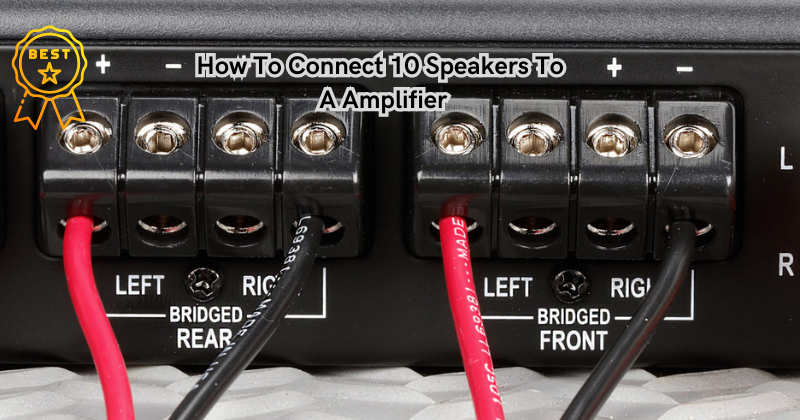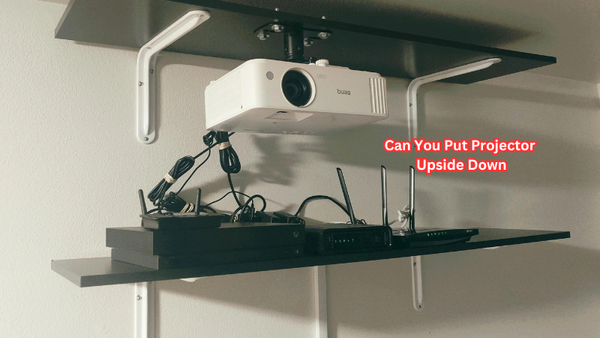Connecting multiple speakers to an amplifier can enhance the audio experience, creating a dynamic and immersive sound environment. However, achieving this setup requires careful consideration to ensure optimal performance and prevent potential damage to the amplifier or speakers.
This guide provides practical insights on effectively connecting ten speakers to an amplifier, covering key considerations such as impedance matching, wiring configurations, and speaker selectors.
By understanding the technical aspects and employing proper installation techniques, audio enthusiasts can achieve a robust multi-speaker setup that maximizes sound quality while safeguarding the integrity of their audio equipment.
How To Connect 10 Speakers To A Amplifier: Key Considerations
Now that you have decided to connect ten speakers to an amplifier, it is essential to understand the various factors that can affect the performance of your setup. Here are some key considerations to keep in mind:
Impedance Matching
Impedance matching is the first and most crucial consideration when connecting multiple speakers to an amplifier. In simple terms, impedance refers to the electrical resistance of a circuit and is measured in ohms. Each speaker has its impedance rating, typically 4, 8, or 16 ohms.
The goal is to match the total speaker load (impedance) to the amplifier's output impedance for optimal performance. If the speaker load is too low, it can cause the amplifier to overheat and potentially damage both the speakers and the amplifier. On the other hand, if the load is too high, it can lead to a weaker sound output and also risk damaging the audio equipment.
To achieve proper impedance matching with ten speakers, they can be connected in series or parallel. In a series connection, the speakers are wired one after another, effectively adding their impedance values together.
For example, connecting two 8-ohm speakers in series would result in a total load of 16 ohms (8+8). On the other hand, parallel wiring involves connecting each speaker's positive and negative terminals together, resulting in an overall lower impedance. For 10 speakers, a combination of both series and parallel wiring may be necessary to achieve the desired impedance load.
Minimum impedance should also be taken into consideration, as most amplifiers have a minimum impedance rating that they can handle.
Speaker impedance for one speaker or a combination of speakers in a series should not fall below this minimum rating to avoid damaging the amplifier.
Identical speakers with matching impedance ratings are the ideal choice for a multi-speaker setup. However, if different speakers are used, their impedance values must be carefully calculated to ensure proper matching.
Wiring Configurations
Aside from impedance, another crucial aspect to consider when connecting multiple speakers to an amplifier is the wiring configuration. There are various ways to wire 10 speakers, each with its own benefits and limitations in terms of sound quality, power distribution, and ease of installation. Some common wiring configurations include:
- Series/Parallel Wiring – As mentioned earlier, this method combines both series and parallel wiring to achieve the desired impedance load. It is a versatile and efficient way to connect ten speakers while maintaining proper load distribution. However, it can be more challenging to install due to the complex wiring process.
- Daisy Chain Wiring – With daisy chain wiring, each speaker is connected to the next one in a chain-like fashion, with the last speaker's negative terminal connected back to the amplifier. It is relatively easy to install and provides equal power distribution to each speaker. However, this method can result in a weaker sound output due to voltage drops along the chain.
- Bi-Wiring – This involves connecting two sets of wires from the amplifier to each speaker, one for high-frequency signals and another for low-frequency signals. Bi-wiring can improve sound quality and power distribution but requires an amplifier with bi-wiring capabilities and special wiring configurations on the speakers themselves.
It's crucial to carefully research and understand each wiring configuration's pros and cons before deciding which method is most suitable for your setup. Wiring more than two speakers to the same output on an amplifier is not recommended, as it can cause uneven power distribution and affect sound quality. And more than one speaker should never be connected to a single output terminal on the amplifier.
Speaker Selector Switches
A speaker selector switch is a device that allows you to connect multiple speakers to one amplifier while controlling which speakers receive audio signals at any given time.
It works by directing the amplified signal from the amplifier to each speaker individually, depending on which switch is selected. This not only makes it convenient to switch between different speaker setups or zones but also helps maintain proper impedance matching and prevent potential damage to the amplifier.
When using a speaker selector switch, it's crucial to ensure that the switch can handle your desired load and has enough power-handling capabilities for all connected speakers. Additionally, some switches offer additional features, such as individual volume control for each speaker or separate audio inputs for different sources.
Amplifier Power Handling
Last but not least, when connecting ten speakers to an amplifier, it's crucial to consider the amplifier's power handling capabilities. Each speaker has its own power rating, and the total power output of all connected speakers should not exceed the amplifier's capabilities.
Failure to do so can result in distorted sound or even damage to the amplifier. To determine the optimal power handling for your setup, you must first understand the amplifier's power rating and how impedance affects it.
In general, a higher impedance load requires more power from the amplifier to achieve the same sound volume as a lower impedance load.
Therefore, when connecting multiple speakers with different impedance values, it's essential to carefully calculate and match the total speaker load to ensure proper power handling by the amplifier. Additionally, regularly monitoring the amplifier's temperature and volume levels can help prevent overheating and potential damage to the equipment.
Room Layout and Acoustics
Aside from the technical aspects of connecting multiple speakers to an amplifier, it's also crucial to consider the room layout and acoustics. The placement of speakers can significantly impact sound quality and distribution, especially when dealing with ten speakers.
It's essential to experiment with different speaker placements and angles to determine the best configuration for optimal sound in your space. Additionally, taking into account the room's acoustics, such as wall materials and furniture, can help further enhance the sound quality and reduce unwanted echoes or reflections.
How To Connect 10 Speakers To A Amplifier: Step-by-Step Guide
Now that you understand the key considerations let's dive into the step-by-step process of connecting ten speakers to an amplifier:
- Identify the impedance of each speaker and calculate the total load.
- Determine the appropriate wiring configuration based on your desired impedance load and research its wiring process.
- Gather all necessary equipment, including wires, connectors, speaker selector switch (if applicable), and tools such as wire cutters and strippers.
- Begin by connecting the amplifier to the speaker selector switch (if using one) following the manufacturer's instructions.
- Connect the speakers to the selector switch or directly to the amplifier, depending on your chosen wiring configuration, ensuring proper polarity and impedance matching.
- Test the sound output and make any necessary adjustments, such as repositioning speakers or adjusting volume levels.
- Regularly monitor the amplifier's temperature and volume levels to prevent overheating or damage.
- Experiment with different speaker placements and angles to find the optimal configuration for your space
- Enjoy your new sound setup!
With proper research, planning, and careful execution, connecting ten speakers to an amplifier can result in an impressive and immersive audio experience.
Tips for Optimal Sound Quality
- Consider using high-quality wires and connectors for better sound transmission.
- Ensure all connections are secure and properly insulated to prevent signal loss or damage.
- Regularly clean and maintain the equipment to prolong its lifespan.
- Experiment with different speaker placements, angles, and configurations for optimal sound quality.
By following these tips and understanding the key considerations, you can successfully connect ten speakers to an amplifier and enjoy a superior audio experience in your space. Remember to always prioritize safety and proper equipment handling while experimenting with different setups.
FAQs
How do I connect more speakers to my amp?
You can connect more speakers to your amplifier by using a speaker selector switch or wiring the speakers in series or parallel. However, it's essential to carefully research and understand each method's pros and cons before deciding which is most suitable for your setup.
What happens if I exceed my amplifier's power handling capabilities?
Exceeding an amplifier's power handling capabilities can lead to distorted sound, damage to the amplifier, or even cause it to overheat. It's crucial to ensure proper power handling by matching the total speaker load with the amplifier's capabilities.
How many amps for four speakers?
The required amp size for 4 speakers depends on the power handling capabilities of each speaker and their combined impedance load. It's essential to carefully calculate and match the total load to ensure proper power handling by the amplifier. If in doubt, consult an audio professional for assistance.
Can I mix different types of speakers when connecting them to an amplifier?
You can mix different types of speakers, such as bookshelf and floor-standing speakers, when connecting them to an amplifier. However, it's crucial to carefully calculate and match the total load to ensure proper power handling by the amplifier. It's also recommended that speakers with similar impedance values be used for optimal sound quality.
Conclusion
In conclusion, connecting ten speakers to an amplifier demands meticulous planning, technical understanding, and a commitment to preserving audio quality.
Adhering to proper impedance matching, thoughtful speaker wiring configurations, and the potential use of a speaker selector switch are crucial elements in achieving a successful multi-speaker setup. Additionally, awareness of the amplifier's power handling capabilities and the nuances of room acoustics can significantly impact the auditory experience.
By investing time in testing and fine-tuning the system, enthusiasts can ensure a balanced, immersive sound output that complements the intended audio environment.
Ultimately, the careful execution of these steps not only maximizes the potential of the speaker-amplifier setup but also prolongs the longevity of the equipment, allowing for continued enjoyment of high-quality audio reproduction.





